
Hornblende is a complex inosilicate series of minerals. It is not a recognized mineral in its own right, but the name is used as a general or field term, to refer to a dark amphibole. Hornblende minerals are common in igneous and metamorphic rocks.

Sekaninaite ((Fe+2,Mg)2Al4Si5O18) is a silicate mineral, the iron-rich analogue of cordierite.

Cristobalite is a mineral polymorph of silica that is formed at very high temperatures. It has the same chemical formula as quartz, SiO2, but a distinct crystal structure. Both quartz and cristobalite are polymorphs with all the members of the quartz group, which also include coesite, tridymite and stishovite. It is named after Cerro San Cristóbal in Pachuca Municipality, Hidalgo, Mexico.
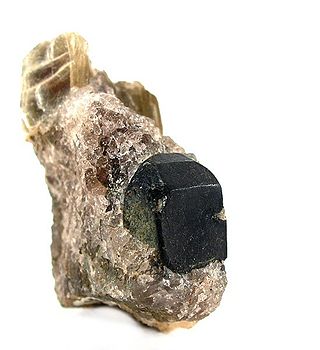
Triphylite is a lithium iron(II) phosphate mineral with the chemical formula LiFePO4. It is a member of the triphylite group and forms a complete solid solution series with the lithium manganese(II) phosphate, lithiophilite. Triphylite crystallizes in the orthorhombic crystal system. It rarely forms prismatic crystals and is more frequently found in hypidiomorphic rock. It is bluish- to greenish-gray in color, but upon alteration becomes brown to black.

Baotite Ba4Ti4(Ti, Nb, Fe)4(Si4O12)O16Cl is a rare mineral recognized as having a unique four-fold silicate ring. Crystals are tetragonal, though commonly deformed to the extent of appearing monoclinic. Named for the locality of first discovery, Baotou, China, baotite has been found in hydrothermal veins and alkalic rocks in various locations around the world.
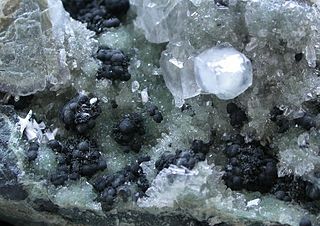
Julgoldite is a member of the pumpellyite mineral series, a series of minerals characterized by the chemical bonding of silica tetrahedra with alkali and transition metal cations. Julgoldites, along with more common minerals like epidote and vesuvianite, belong to the subclass of sorosilicates, the rock-forming minerals that contain SiO4 tetrahedra that share a common oxygen to form Si2O7 ions with a charge of 6- (Deer et al., 1996). Julgoldite has been recognized for its importance in low grade metamorphism, forming under shear stress accompanied by relatively low temperatures (Coombs, 1953). Julgoldite was named in honor of Professor Julian Royce Goldsmith (1918–1999) of the University of Chicago.
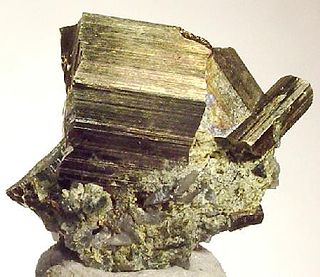
Cubanite is a copper iron sulfide mineral that commonly occurs as a minor alteration mineral in magmatic sulfide deposits. It has the chemical formula CuFe2S3 and when found, it has a bronze to brass-yellow appearance. On the Mohs hardness scale, cubanite falls between 3.5 and 4 and has a orthorhombic crystal system. Cubanite is chemically similar to chalcopyrite, however it is the less common copper iron sulfide mineral due to crystallization requirements.

Beraunite is an iron phosphate mineral. It was first described by August Breithaupt for an occurrence in Beraun currently in the Czech Republic. Beraunite occurs as a secondary mineral in iron ore deposits, and as an alteration product of primary phosphate minerals in granite pegmatites.
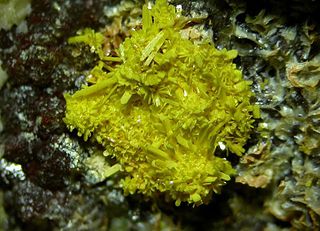
Bergenite is a rare uranyl phosphate of the more specific phosphuranylite group. The phosphuranylite-type sheet in bergenite is a new isomer of the group, with the uranyl phosphate tetrahedra varying in an up-up-down, same-same-opposite (uuduudSSOSSO) orientation. All bergenite samples have been found in old mine dump sites. Uranyl minerals are a large constituent of uranium deposits.
Mooihoekite is a copper iron sulfide mineral with chemical formula of Cu9Fe9S16. The mineral was discovered in 1972 and received its name from its discovery area, the Mooihoek mine in Transvaal, South Africa.

Sinoite is rare mineral with the chemical formula Si2N2O. It was first found in 1905 in chondrite meteorites and identified as a distinct mineral in 1965. Sinoite crystallizes upon meteorite impact as grains smaller than 0.2 mm surrounded by Fe-Ni alloys and the mineral enstatite. It is named after its SiNO composition and can be prepared in the laboratory as a silicon oxynitride ceramic.
Bobfergusonite is a mineral with formula Na2Mn5FeAl(PO4)6. The mineral varies in color from green-brown to red-brown. It was discovered in 1986 in Manitoba, Canada, and named for Robert Bury Ferguson (born 1920). As of 2012, the mineral has only been found in Canada and Argentina.

Hidalgoite, PbAl3(AsO4)(SO4)(OH)4, is a rare member of the beudantite group and is usually classified as part of the alunite family. It was named after the place where it was first discovered, the Zimapán mining district, Hidalgo, Mexico. At Hidalgo where it was initially discovered, it was found as dense white masses in alternating dikes of quartz latite and quartz monzonite alongside other secondary minerals such as sphalerite, arsenopyrite, cerussite and trace amounts of angelsite and alamosite, it was then rediscovered at other locations such as Australia where it occurs on oxidized shear zones above greywacke shales especially on the anticline prospects of the area, and on fine grained quartz-spessartine rocks in Broken Hill, Australia. Hidalgoite specimens are usually associated with copper minerals, clay minerals, iron oxides and polymetallic sulfides in occurrence.
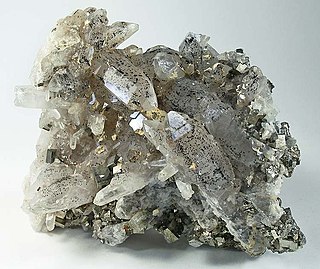
The mineral hubeite, Ca
2Mn2+
Fe3+
[Si
4O
12(OH)]·(H
2O)
2, is a sorosilicate of the Si
4O
13 group. Structurally it also belongs to the Akatoreite group. It was found and named after the province of Hubei, China. It is common to iron ores in a mine of that region. It occurs mainly as aggregates of fan like crystals. It is dark to pale brown, has orange-brown streak and is vitreous. Hubeite has a hardness of 5.5 in the Mohs scale, one good cleavage and conchoidal fracture. It is triclinic with a space group of P1*. The structure of hubeite is very uncommon, and in fact there is only one other mineral that fits the Si
4O
13 group, which is ruizite.
Moorhouseite is a rare mineral with the formula CoSO4•6H2O, a naturally occurring cobalt(II) sulfate hexahydrate. It is the lower-hydrate-equivalent of bieberite (heptahydrate) and aplowite (hexahydrate). It is also hydrated equivalent of cobaltkieserite. It occurs together with moorhouseite within efflorescences found in the Magnet Cove Barium Corporation mine in Walton, Nova Scotia, Canada.
Falsterite is a rare phosphate mineral with the formula Ca2MgMn2+2(Fe2+0.5Fe3+0.5)4Zn4(PO4)8(OH)4(H2O)14. It is a pegmatitic mineral, related to the currently approved mineral ferraioloite.
Filipstadite is a very rare mineral of the spinel group, with the formula (Mn,Mg)(Sb5+0.5Fe3+0.5)O4. It is isometric, although it was previously though to be orthorhombic. When compared to a typical spinel, both the octahedral and tetrahedral sites are split due to cation ordering. Filipstadite is chemically close to melanostibite. The mineral comes from Långban, Sweden, a manganese skarn deposit famous for many rare minerals.
Nuragheite is a rare natural thorium molybdate, formula Th(MoO4)2·H2O, discovered in Su Seinargiu, Sarroch, Cagliari, Sardegna, Italy. This locality is also a place of discovery of the other thorium molybdate - ichnusaite, which is a trihydrate.
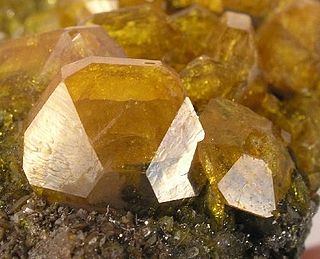
Sturmanite is a rare sulfate mineral with the chemical formula Ca6Fe3+2(SO4)2.5(B(OH)4)(OH)12 · 25 H2O. It crystallises in the tetragonal system and it has a Moh's hardness of 2.5. Sturmanite has a bright yellow to amber colour and falls in the ettringite group. It was named after Bozidar Darko Sturman (born 1937), Croatian-Canadian mineralogist and Curator Emeritus of Mineralogy, Royal Ontario Museum.

Capgaronnite is a mineral that forms small tufted aggregates or isolated crystals with a maximum width of 0.02mm and a maximum length of 0.1mm. This mineral is related to perroudite in chemical composition and crystal structure. Capgaronnite is associated with secondary minerals of Cu like olivenite, cyanotrichite, and tennantite.














